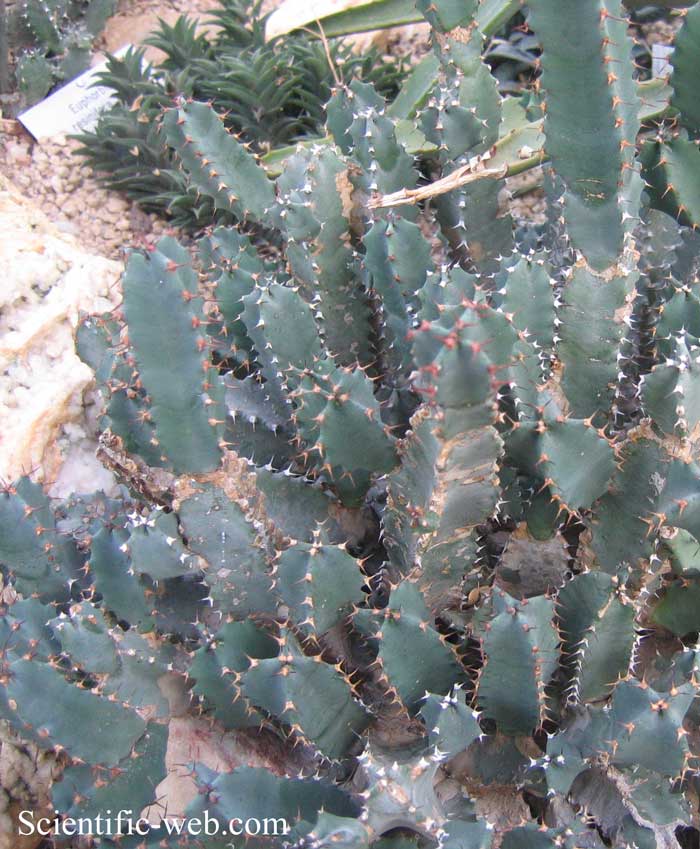
Euphorbia resinifera, Photo: Michael Lahanas
Classification System: APG IV
Superregnum: Eukaryota
Regnum: Plantae
Cladus: Angiosperms
Cladus: Eudicots
Cladus: Core eudicots
Cladus: Rosids
Cladus: Eurosids I
Ordo: Malpighiales
Familia: Euphorbiaceae
Subfamilia: Euphorbioideae
Tribus: Euphorbieae
Subtribus: Euphorbiinae
Genus: Euphorbia
Species: Euphorbia resinifera
Name
Euphorbia resinifera O.Berg, 1863
Synonyms
Homotypic
Tithymalus resinifer (O.Berg) H.Karst., Deut. Fl.: 587 (1882).
Euphorbia resinifera var. typica Croizat, Desert Pl. Life 14: 46 (1942), not validly publ.
Heterotypic
Euphorbia resinifera var. chlorosoma Croizat, Desert Pl. Life 14: 46 (1942).
Distribution
Native distribution areas:
Continental: Africa
Regional: Northern Africa
Morocco
References: Brummitt, R.K. 2001. TDWG – World Geographical Scheme for Recording Plant Distributions, 2nd Edition
References
Primary references
Berg, O.K. in O.C.Berg & C.F.Schmidt, 1863. Darstellung und Beschreibung samtlicher in der Pharmacopoea borussica aufgefuhrten offizinellen Gewachse 4: 34d verso.
Links
Govaerts, R. et al. 2020. Euphorbia resinifera in World Checklist of Selected Plant Families. The Board of Trustees of the Royal Botanic Gardens, Kew. Published on the internet. Accessed: 2020 Jul 08. Reference page.
International Plant Names Index. 2020. Euphorbia resinifera. Published online. Accessed: Jul 08 2020.
Govaerts, R. et al. 2020. Euphorbia resinifera in Kew Science Plants of the World online. The Board of Trustees of the Royal Botanic Gardens, Kew. Published on the internet. Accessed: 2020 Jul 08. Reference page.
Tropicos.org 2020. Euphorbia resinifera. Missouri Botanical Garden. Published on the internet. Accessed: 2020 Jul 08.
USDA, ARS, Germplasm Resources Information Network. Euphorbia resinifera in the Germplasm Resources Information Network (GRIN), U.S. Department of Agriculture Agricultural Research Service. Accessed: 08-Apr-12.
Vernacular names
Euphorbia resinifera, the resin spurge, is a species of spurge native to Morocco, where it occurs on the slopes of the Atlas Mountains. The dried latex of the plant was used in ancient medicine. It contains resiniferatoxin, a capsaicin analog tested as an analgesic since 1997.
Growth
It is a shrub growing to 61 centimetres (24 in) tall, forming multi-stemmed cushion-shaped clumps up to 2 metres (6 ft 7 in) wide. The stems are erect, succulent, superficially like a cactus, four-angled, with short but sharp pairs of 6-millimetre (0.24 in) spines on the angles, spaced about 1-centimetre (0.39 in) apart up the stem.[1]
Geographical distribution
Euphorbia resinifera is a species of spurge native to Morocco, where it occurs on the slopes of the Atlas Mountains.[1] It is similar to its relative Euphorbia echinus, which occurs on the Moroccan coast and the Canary Islands. Due to its origin it is also called the African spurge.[2]
Chemical constituents
Euphorbia resinifera contains a milky fluid or latex, which in its dried form is called Euphorbium. It has high concentration of resiniferatoxin, an analog of capsaicin, the primary vanilloid compound found in hot peppers. It can interact with a vanilloid receptor on primary sensory neurons mediating pain (nociception) and neurogenic inflammation. The pain sensing cation channel is TRPV1.[3] Resiniferatoxin has been used as a starting point in the development of a novel class of analgesics. Desensitization to topical resiniferatoxin has been tested in clinical trials to evaluate its potential to relieve neuropathic pain, as in diabetic polyneuropathy and postherpetic neuralgia.[3] Resiniferatoxin injected subcutaneously into a rat hind paw several minutes before a surgical incision reduced postsurgical pain for 10 days in a NIH study published March 2018.[4] It has been tested to treat pain with advanced cancer.[5]
Resiniferatoxin was isolated in 1975.[3] Euphorbium has been used since at least its first written record from the time of Roman Emperor Augustus.[3]
References
Huxley, A., ed. (1992). New RHS Dictionary of Gardening. ISBN 978-0-333-47494-5.
"Euphorbia resinifera O. Berg GRIN-Global".
Appendino, Giovanni; Szallasi, Arpad (1997). "Euphorbium: Modern research on its active principle, resiniferatoxin, revives an ancient medicine". Life Sciences. 60 (10): 681–696. doi:10.1016/S0024-3205(96)00567-X. PMID 9064473.
Raithel, Stephen J.; Sapio, Matthew R.; LaPaglia, Danielle M.; Iadarola, Michael J.; Mannes, Andrew J. (2018). "Transcriptional Changes in Dorsal Spinal Cord Persist after Surgical Incision Despite Preemptive Analgesia with Peripheral Resiniferatoxin". Anesthesiology. 128 (3): 620–635. doi:10.1097/ALN.0000000000002006. PMID 29271803. S2CID 46767651.
National Institute of Dental and Craniofacial Research Resiniferatoxin to Treat Severe Pain Associated With Advanced Cancer December 8, 2008, retrieved February 28, 2018
Retrieved from "http://en.wikipedia.org/"
All text is available under the terms of the GNU Free Documentation License

